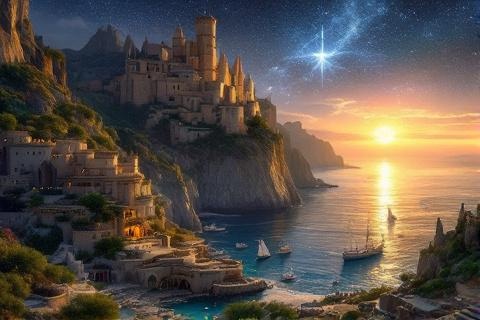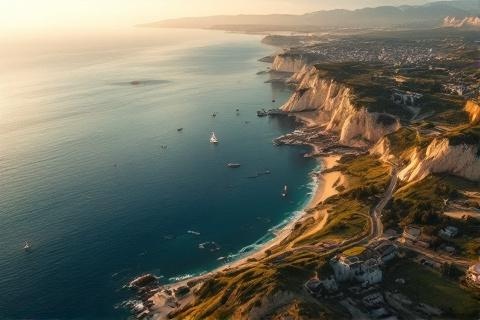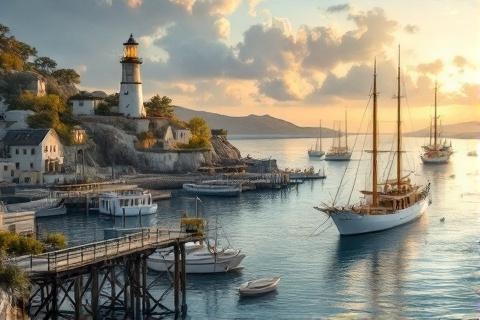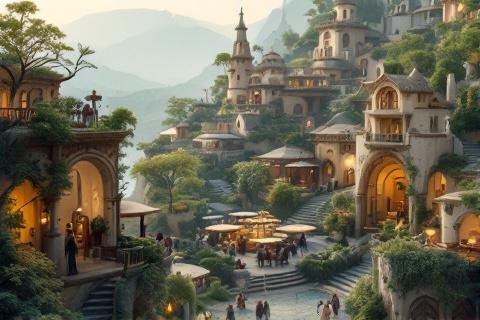
Arvernien: Haven of Hope in Beleriand
Unveiling the Mysteries of Middle-earth's Western Refuge
Geographic Location and Natural Features

Arvernien stood as a testament to survival at the crucial junction where the
mighty River Sirion emptied into Belegaer, the Great Sea. This strategic
location, described in detail in The Silmarillion, served
as one of the last havens for the refugees of Beleriand
following the devastating battles against Morgoth. The
settlement gained particular significance after the Fall of
Gondolin, when many survivors made their way south to
establish a new home.
The natural defenses of Arvernien proved invaluable to its survival during the
tumultuous First Age. Sheer cliffs rose majestically from the
sea, creating an imposing barrier against potential invaders. These geological
formations, combined with numerous hidden coves and natural harbor structures,
made the haven both defensible and suitable for maritime activities.
The waters around Arvernien teemed with life, providing sustenance for its
inhabitants. Schools of fish filled the coastal waters, while beds of shellfish
lined the shores. This abundance of marine resources ensured that the refugee
population could sustain itself even in times of hardship, when trade and
agriculture proved difficult.
Arvernien's position as the westernmost haven of Beleriand carried both
practical and symbolic significance. From this vantage point, the settlement
maintained crucial connections with the Isle of Balar, where Círdan the
Shipwright and Gil-galad maintained their
realm. This location also placed it closest to Valinor in the
Uttermost West, a fact that would later prove significant in the tales of
Eärendil the Mariner.
Architecture and Settlement Design

The architecture of Arvernien reflected the unique collaboration between the
Elves of Gondolin and the Edain
who dwelt there. The Elven influence brought grace and elegance to the
structures, while the practical knowledge of Men contributed to
their functionality. This architectural fusion created a distinctive style that
differed from both the hidden city of Gondolin and the settlements of Hithlum.
The builders of Arvernien demonstrated remarkable skill in incorporating their
dwellings into the natural cliff faces. They carved chambers and halls into the
rock while preserving its structural integrity, creating homes that offered both
protection and comfort. These cliff-integrated structures remained cool in
summer and warm in winter, showcasing the wisdom of their designers.
The harbor of Arvernien housed several of the famous white ships of the
Teleri, salvaged and maintained by the skilled shipwrights who
had learned their craft from Círdan himself. These vessels, with their swan-like
prows and silver sails, represented some of the finest examples of Elvish
shipbuilding in Middle-earth. The docking facilities were
carefully designed to protect these precious craft from the worst of the sea's
fury.
The defensive architecture of Arvernien took full advantage of the natural
terrain. Watchtowers were positioned at strategic points along the cliffs, while
the approaches from land were guarded by walls that seemed to grow from the very
rock itself. The builders incorporated these defensive elements so skillfully
that they appeared as natural extensions of the landscape rather than imposing
fortifications.
The Haven's Harbor

The natural harbor of Arvernien benefited from unique geological features that
created a deep-water port sheltered from the worst storms of Belegaer. High
cliffs wrapped around the bay in a protective embrace, while underwater
formations broke the force of incoming waves. This combination of features
allowed ships to dock safely even during the turbulent weather that frequently
battered the western coast of Beleriand.
The shipbuilding facilities of Arvernien represented some of the finest examples
of First Age maritime infrastructure. Multiple dry docks and construction berths
lined the protected inner harbor, while workshops dedicated to sail-making,
rope-weaving, and wood-crafting clustered nearby. These facilities proved
crucial in maintaining the fleet that connected Arvernien with the Isle of
Balar.
A great lighthouse stood as the crown jewel of Arvernien's maritime
infrastructure. Built upon the highest cliff overlooking the harbor entrance,
its beacon guided ships safely home through darkness and storm. Supporting
navigation structures, including smaller signal fires and carefully positioned
markers, helped vessels negotiate the sometimes treacherous approach to the
harbor.
The trading facilities of Arvernien included extensive warehouses and storage
areas carved into the cliffs above the flood line. These structures housed goods
from across Beleriand, as well as materials salvaged from fallen realms like
Gondolin and Doriath. The storage areas were carefully
designed to protect valuable items from both the elements and potential raiders.
Natural Resources and Environment
The waters surrounding Arvernien supported an incredibly diverse ecosystem.
Great schools of fish migrated through the area seasonally, while resident
species inhabited the rocky coastline throughout the year. The abundance of
marine life attracted seabirds in great numbers, creating a vibrant coastal
environment that provided both sustenance and beauty for the haven's
inhabitants.
The delta where the Sirion met the sea created fertile agricultural land that
the refugees of Arvernien carefully cultivated. Despite the challenges of
farming in a coastal environment, the rich soil supported gardens and small
fields that supplemented the haven's food supply. The river's regular deposits
of silt continually renewed the soil's fertility.
The region provided an abundance of natural materials that the craftspeople of
Arvernien put to good use. Local stone proved excellent for building, while
specific varieties were prized for ornamental work. The coastal forests supplied
timber for both construction and shipbuilding, though these resources were
carefully managed to prevent depletion.
Fresh water flowed abundantly in Arvernien, thanks to both the River Sirion and
numerous springs that emerged from the cliff faces. The residents developed
sophisticated systems to collect and distribute this water throughout the
settlement. They also discovered several natural caverns where fresh water
collected, providing emergency reserves during times of siege or drought.
Living Spaces and Community Areas

The social fabric of Arvernien was unique in Beleriand, as it represented one of
the few places where Elves and Men lived together in truly integrated
communities. The refugees from Gondolin and Doriath mixed freely with the Edain
who had joined them, creating neighborhoods where children of both races played
together and adults shared their different skills and knowledge. This
integration proved particularly important in the household of Eärendil and
Elwing, where the two bloodlines were united.
Public spaces in Arvernien served as vital centers of community life. Markets
bustled with activity as traders from Balar and other surviving settlements
brought their goods, while local craftspeople displayed their works. These
gathering places became crucial forums where news was shared and communities
maintained their cultural traditions despite their exile.
The craftsmen's quarter of Arvernien housed workshops where both Elven and human
artisans practiced their trades. Shipwrights worked alongside carpenters, while
weavers and metalworkers shared techniques passed down through generations.
These workshops produced both practical items needed for daily life and
beautiful works that helped maintain the artistic traditions of the lost realms.
Throughout Arvernien, gardens and recreational spaces provided respite from the
hardships of exile. Elven gardeners created beautiful spaces that reminded them
of their lost homes, while also incorporating practical elements like herbs and
fruit trees. These areas served as places of healing and reflection, where the
inhabitants could find peace despite the shadow of war that loomed over
Beleriand.
Defensive Features

The natural cliff formations that surrounded Arvernien formed an almost
impregnable barrier against attack from both land and sea. These towering walls
of stone, weathered by countless years of wind and wave, created a natural
fortress that required minimal enhancement for defensive purposes. The few
vulnerable approaches were easily fortified, making the haven one of the most
secure settlements in late First Age Beleriand.
Strategic watchpoints were established along the coastline, providing clear
views of both the sea approaches and the inland routes. These positions were
carefully chosen to maximize visibility while maintaining concealment, allowing
defenders to spot potential threats long before they reached the haven. The
watchpoints maintained constant communication through a sophisticated system of
signals.
Throughout Arvernien, a network of hidden paths and escape routes provided
emergency egress options for the population. These secret ways, known only to
trusted members of the community, led to concealed caves and protected coves
where boats could be hidden. Such routes proved invaluable during the Third
Kinslaying, when many inhabitants managed to escape the assault of the sons of
Fëanor.
The fortified sections of Arvernien demonstrated the defensive wisdom gained
from the fall of other Elven realms. Strong points were established at key
locations, with storage for weapons and supplies secured against long sieges.
These fortifications were designed to be defended by relatively small numbers of
warriors, making efficient use of the limited military resources available to
the haven.
